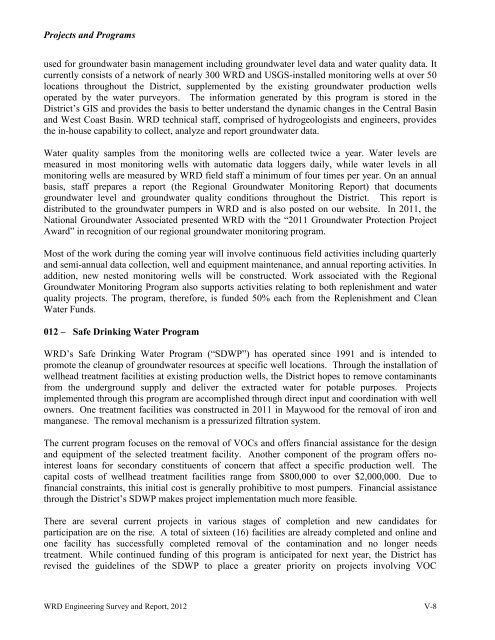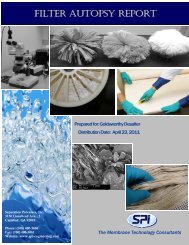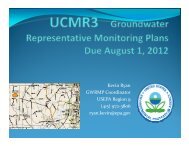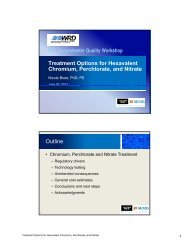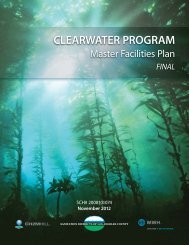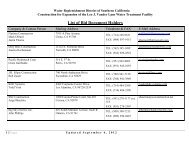Download pdf - Water Replenishment District of Southern California
Download pdf - Water Replenishment District of Southern California
Download pdf - Water Replenishment District of Southern California
Create successful ePaper yourself
Turn your PDF publications into a flip-book with our unique Google optimized e-Paper software.
Projects and Programs<br />
used for groundwater basin management including groundwater level data and water quality data. It<br />
currently consists <strong>of</strong> a network <strong>of</strong> nearly 300 WRD and USGS-installed monitoring wells at over 50<br />
locations throughout the <strong>District</strong>, supplemented by the existing groundwater production wells<br />
operated by the water purveyors. The information generated by this program is stored in the<br />
<strong>District</strong>’s GIS and provides the basis to better understand the dynamic changes in the Central Basin<br />
and West Coast Basin. WRD technical staff, comprised <strong>of</strong> hydrogeologists and engineers, provides<br />
the in-house capability to collect, analyze and report groundwater data.<br />
<strong>Water</strong> quality samples from the monitoring wells are collected twice a year. <strong>Water</strong> levels are<br />
measured in most monitoring wells with automatic data loggers daily, while water levels in all<br />
monitoring wells are measured by WRD field staff a minimum <strong>of</strong> four times per year. On an annual<br />
basis, staff prepares a report (the Regional Groundwater Monitoring Report) that documents<br />
groundwater level and groundwater quality conditions throughout the <strong>District</strong>. This report is<br />
distributed to the groundwater pumpers in WRD and is also posted on our website. In 2011, the<br />
National Groundwater Associated presented WRD with the “2011 Groundwater Protection Project<br />
Award” in recognition <strong>of</strong> our regional groundwater monitoring program.<br />
Most <strong>of</strong> the work during the coming year will involve continuous field activities including quarterly<br />
and semi-annual data collection, well and equipment maintenance, and annual reporting activities. In<br />
addition, new nested monitoring wells will be constructed. Work associated with the Regional<br />
Groundwater Monitoring Program also supports activities relating to both replenishment and water<br />
quality projects. The program, therefore, is funded 50% each from the <strong>Replenishment</strong> and Clean<br />
<strong>Water</strong> Funds.<br />
012 – Safe Drinking <strong>Water</strong> Program<br />
WRD’s Safe Drinking <strong>Water</strong> Program (“SDWP”) has operated since 1991 and is intended to<br />
promote the cleanup <strong>of</strong> groundwater resources at specific well locations. Through the installation <strong>of</strong><br />
wellhead treatment facilities at existing production wells, the <strong>District</strong> hopes to remove contaminants<br />
from the underground supply and deliver the extracted water for potable purposes. Projects<br />
implemented through this program are accomplished through direct input and coordination with well<br />
owners. One treatment facilities was constructed in 2011 in Maywood for the removal <strong>of</strong> iron and<br />
manganese. The removal mechanism is a pressurized filtration system.<br />
The current program focuses on the removal <strong>of</strong> VOCs and <strong>of</strong>fers financial assistance for the design<br />
and equipment <strong>of</strong> the selected treatment facility. Another component <strong>of</strong> the program <strong>of</strong>fers nointerest<br />
loans for secondary constituents <strong>of</strong> concern that affect a specific production well. The<br />
capital costs <strong>of</strong> wellhead treatment facilities range from $800,000 to over $2,000,000. Due to<br />
financial constraints, this initial cost is generally prohibitive to most pumpers. Financial assistance<br />
through the <strong>District</strong>’s SDWP makes project implementation much more feasible.<br />
There are several current projects in various stages <strong>of</strong> completion and new candidates for<br />
participation are on the rise. A total <strong>of</strong> sixteen (16) facilities are already completed and online and<br />
one facility has successfully completed removal <strong>of</strong> the contamination and no longer needs<br />
treatment. While continued funding <strong>of</strong> this program is anticipated for next year, the <strong>District</strong> has<br />
revised the guidelines <strong>of</strong> the SDWP to place a greater priority on projects involving VOC<br />
WRD Engineering Survey and Report, 2012 V-8


